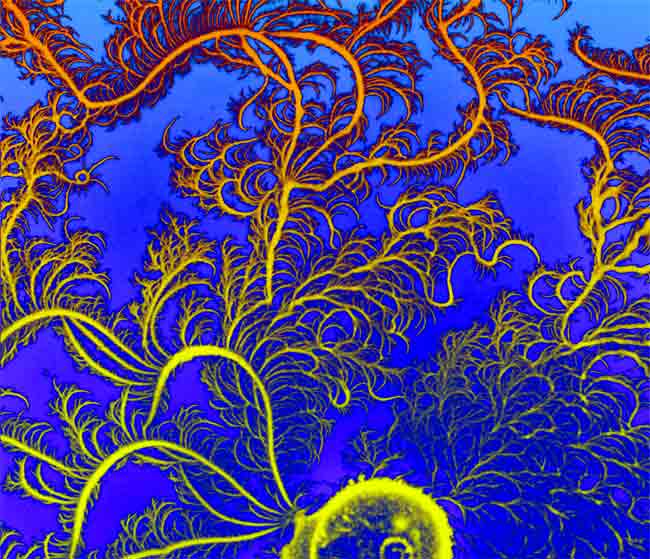Bacteria May Unlock Mysteries of Human Body

Big ideas come in small packages. In the case of Shewanella bacteria, the parcel is microscopic. But this tiny microbe could hold the keys to alternative energy production, toxic waste cleanup and, most surprising of all, how human bodies work.
One of the most versatile types of bacteria around, Shewanella can live on land, deep inside the Earth, or underwater. As their habitat changes, Shewanella change with it, finding new ways to breathe.
Daniel Bond, a University of Minnesota microbiologist, said that all living organisms bring in electrons with the food they eat. Cells use these electrons to generate energy, but must eventually get rid of the electrons. Humans do this by breathing in oxygen. The electrons hitchhike on the molecules of oxygen, cling on as those molecules change into carbon dioxide, and then leave the body when the person breathes out. Shewanella can do this as well, but not underground, where oxygen is scarce. Instead, in that environment, the bacteria get rid of electrons by attaching them to nearby metals.
Therein lies the link to alternative energy.
In the lab, scientists have long known that they could subtitute an electrode for these natural metals, effectively turning bacteria into teeny, tiny electric generators. The problem was, nobody knew how the bacteria moved electrons from place to place.
In fact, Bond said, such a feat shouldn't, technically, be possible. Like all cells, bacteria are surrounded by a fatty membrane. "It's supposed to be a perfect insulator, preventing electrons from getting in or out," Bond said, "but we knew it was happening anyway. We just didn't know how."
Bond and his team changed that. In the March 3, 2008, issue of the Proceedings of the National Academy of Sciences, they announced they'd found a chemical compound that allowed electrons to pass through the fatty membrane and helped them travel to nearby metals. Turns out, the miracle that made Shewanella electron transfer possible was simple riboflavin, otherwise known as Vitamin B-2.
Sign up for the Live Science daily newsletter now
Get the world’s most fascinating discoveries delivered straight to your inbox.
The research was funded by the Initiative for Renewable Energy and the Environment, National Science Foundation and National Institutes of Health and Cargill.
Putting information to use
There are two big reasons why Bond's discovery is important. First, understanding how Shewanella bacteria move electrons around can help scientists create better electrodes, designed with the transfer process in mind, which could make it easier to collect more electrons more efficiently.
That's still a small amount of electricity; bacteria are never going to power a house or a car. But that doesn't mean the electricity they produce isn't useful. For instance, Bond pointed out that cities already use many different kinds of bacteria to break down the bad stuff in wastewater treatment plants. If those plants could capture the electricity produced by Shewanella and other bacteria as they eat up the toxins, it could be enough to power the plant.
"We spend millions a year buying electricity so we can power the pumps and pump air into these wastewater plants," he said. "If you could collect that energy back, you could at least break even."
Dan Drell, biologist and program manager at the U.S. Department of Energy Office of Science in Washington, D.C., brought up another intriguing use for Shewanella. He said it, and other electricity producing bacteria, may be able to help clean up toxic waste sites, and Bond's research might help that.
Bacteria can break down many organic toxins. Bacteria can change other pollutants, such as heavy metals, into less dangerous forms by attaching electrons to them. Drell said riboflavin could be used to attract more bacteria and more electrons to the places they were needed most.
"You couldn't break down these metals, but you could change their chemical state," he said. "So instead of, say, flowing through the groundwater into the Columbia River, they stayed put."
Body of work
Bond's research is most important, Drell said, because of what it tells scientists about how cells work. Shewanella's genes had been previously sequenced, he said, and riboflavin was one of the many puzzle pieces that showed up in that sequencing. By figuring out what the riboflavin does, Bond has put a piece of that puzzle into the right place.
"Genome sequence data is just data," Drell said. "Data that means something to somebody becomes information and that has greater value."
How great of value? Drell said this information is the first stepping stone toward understanding how simple, microbial cells work, which could, in turn, be a launch pad to understanding the infinitely more complex cells in the human body.
"The more we learn about what Shewanella cells do and how they work together to account for observed behaviors, the more we can get to the fundamental unit of life on this planet, which is the cell," he said. "If you solve one cell you'd be a long ways toward solving the others. Ultimately this could someday help us understand how our own bodies work."
- Video: Flu Myths and Truths
- Top 10 Mysterious Diseases
- Top 10 Emerging Environmental Technologies









